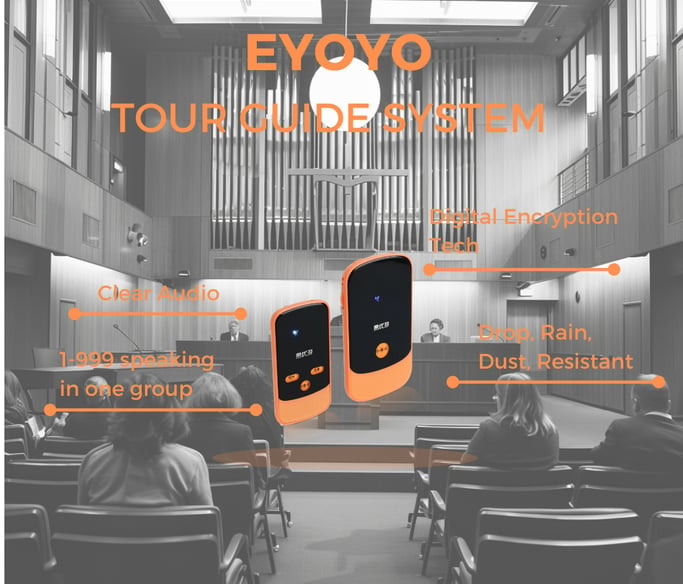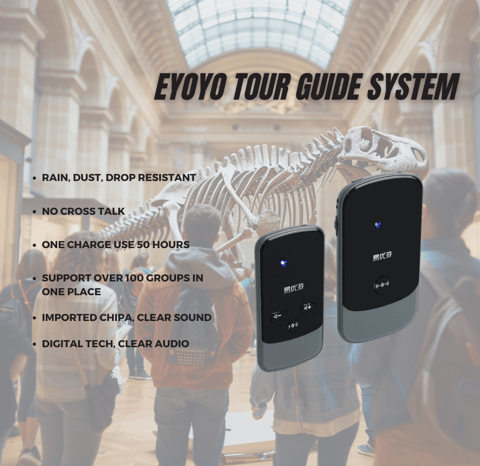How to choose the best wireless portable interpreting tour guide system for a court interpreter
Discover how to select the best wireless portable interpreting device for court interpreters. This blog guides translation and conference service companies through the essentials of picking devices for simultaneous interpretation in legal settings. Learn about key considerations such as audio quality, reliability, and ease of use. Explore the importance of features like clear sound and long battery life. Compare top brands and understand Eyoyo's unique advantages in technology and design. Gain insights into practical use and technological factors that ensure effective communication in courtrooms.
TOUR GUIDE SYSTEM INFORMATION


How to Choose the Best Wireless Portable Interpreting Tour Guide Device for a Court Interpreter
1.Introduction
In the intricate world of legal proceedings, the clarity and accuracy of language interpretation are paramount. For court interpreters, who bridge the gap between languages and cultures, the choice of a wireless portable interpreting tour guide device is crucial. This guide is designed to assist translation companies and conference service companies in selecting the best equipment that meets the unique demands of simultaneous interpretation in a courtroom setting. We'll explore essential factors such as audio quality, reliability, portability, and ease of use, ensuring that interpreters can deliver crystal clear sound and precise translations without fail. Whether it's for a high-stakes trial or a routine legal matter, the right interpreting device can significantly impact the fairness and efficiency of judicial proceedings.
2.Essential Criteria for Selecting an Interpreting Device
2.1 Understanding the Needs of Court Interpreters
Court interpreters play a pivotal role in ensuring justice is accurately served across language barriers. The challenges they face, from fast-paced dialogues to technical legal terminology, demand a wireless portable interpreting tour guide device that offers seamless simultaneous interpretation and crystal clear sound. These devices must be adept at handling the dynamic and often pressure-filled courtroom environment, ensuring interpreters can focus on accuracy and nuance without technical distractions.


2.2 Features of Top Interpreting Devices
Key features that set apart the best interpreting devices include:
Simultaneous Interpretation Capability: Essential for real-time translation, allowing interpreters to listen and speak simultaneously, mirroring the immediacy of the court proceedings.
Crystal Clear Sound Quality: A non-negotiable attribute to ensure every word is understood, despite the courtroom's acoustics or background noise.
Portability and Comfort: Lightweight devices with ergonomic designs that can be easily carried and used throughout lengthy legal sessions.
Advanced Microphones and Receivers: High-quality components that capture and deliver audio without loss or distortion, essential for both the interpreter and the listener.
2.3 Assessing Device Durability and Battery Life
In the high-stakes environment of a courtroom, the reliability of interpreting equipment is paramount. Selecting devices with:
Long Battery Life: Look for rechargeable devices with lithium batteries offering extended operational times to cover long court sessions without the need for frequent recharging.
Robust Construction: Devices should be built to withstand regular use and the occasional accidental drop, ensuring longevity and consistent performance.
Easy Maintenance: Consider devices with straightforward maintenance needs and accessible customer service for quick troubleshooting.
Choosing the right interpreting device involves balancing these critical features with the specific needs of court interpreters, ensuring that every spoken word is accurately and clearly translated.
3.Comparing Popular Tour Guide Systems
3.1 Evaluating Brands and Models
When selecting the ideal wireless portable interpreting tour guide device for court interpreters, it's crucial to consider a range of brands and models to ensure the chosen device meets the rigorous demands of legal proceedings. Brands like Eyoyo have garnered attention for their dedication to audio quality and user-centric design, making them suitable contenders for court interpreting environments. Key factors to examine across different brands and models include:
Simultaneous Interpretation Capability: Ensuring the device supports seamless, real-time translation without lags or interruptions.
Sound Quality: Prioritizing devices that offer crystal clear sound to ensure every legal term and dialogue is accurately captured and conveyed.
Durability and Battery Life: Selecting devices known for their longevity and ability to last through extended court sessions on a single charge.


3.2 Eyoyo Brand Advantage
Leading the Way in Interpreting Solutions
Innovative Technologies: Eyoyo stands out with its adoption of advanced digital encryption technology, ensuring crystal clear sound and no cross-talk or signal interference even when supporting over 100 groups simultaneously. This feature is paramount for court interpreters who require flawless audio transmission for accurate interpretation.
User-Centric Design: Eyoyo prides itself on offering the simplest operation system, significantly reducing setup times and allowing interpreters to focus more on their tasks rather than technical difficulties. This ease of use is coupled with portable and lightweight design, making Eyoyo devices ideal for the dynamic courtroom environment.
Durability and Reliability: Designed to endure the rigorous demands of professional use, Eyoyo devices boast impressive durability against drops, dust, and rain, ensuring they can withstand various environmental challenges encountered in and out of courtrooms.
Extended Battery Performance: Eyoyo's commitment to reliability is further evidenced by their devices' long battery life, with models like the E519 working up to 50 hours and E519S receivers up to 82 hours on a single charge. This extended performance is critical for long court sessions or multiple consecutive interpreting assignments.
Unmatched Versatility: Beyond the courtroom, Eyoyo's systems are versatile enough for translation companies, conference service companies, and educational institutions, offering unparalleled audio clarity and reliability across a broad range of group communication needs. This versatility makes Eyoyo a preferred choice for professionals seeking a single solution that can adapt to various interpreting scenarios.
3.3 Customer Reviews and Professional Recommendations
Gleaning insights from customer reviews and professional recommendations can significantly inform the decision-making process. Professionals within the translation and legal interpretation sectors often share their experiences with different interpreting devices, highlighting their effectiveness in various courtroom scenarios. Key aspects to look out for include:
Ease of Use: Feedback on the device's user interface and any setup complexities can indicate its suitability for fast-paced court environments.
Reliability: Reviews often shed light on the device's performance stability, crucial for uninterrupted court proceedings.
Customer Support: The level of after-sales support offered by the brand, including access to interpreting services and responsiveness to technical inquiries, can be a deciding factor for court interpreters who rely heavily on their equipment.
By carefully evaluating these factors, court interpreters and translation companies can make an informed choice, selecting a device that not only meets the technical requirements of court interpretation but also enjoys positive endorsements from the interpreting community.
4.Technological Considerations
The right technology can significantly enhance the effectiveness of court interpreters, ensuring seamless communication and maintaining the integrity of courtroom proceedings. Here are some crucial technological aspects to consider:
4.1 Wireless Technology and Range
Wireless technology liberates court interpreters from the constraints of wired systems, allowing them to move freely and position themselves optimally within the courtroom for better acoustics and visibility. The range of the wireless system is a critical factor, as it must cover the entire courtroom without loss of signal or quality. This includes reliable wireless receivers and transmitters that maintain a clear connection, regardless of physical barriers or distance within the court. A robust wireless system ensures interpreters can deliver uninterrupted service, fostering an environment where every participant, regardless of language, has equal access to justice.
4.2 Simultaneous Interpretation Features
Simultaneous interpretation demands a sophisticated setup that can handle real-time translation with minimal latency. Key components of an effective system include:
Transmitters: These devices capture the speaker's voice and transmit the audio signal to the interpreter's receiver. High-quality transmitters are essential for capturing every nuance and inflection, which can be crucial in legal settings.
Receivers: Worn by the interpreter (and possibly the audience needing interpretation), these devices pick up the transmitted audio. Receivers must have exceptional reception capabilities to ensure crystal clear sound.
Microphones: The interpreter's microphone is where the translation is spoken into, making its quality paramount. It needs to be sensitive enough to pick up the interpreter's voice clearly but designed to minimize background noise.
Audio Tour Guide System: Although traditionally used in tourism, some courtrooms might adapt audio tour guide systems for their portability and ease of use in providing simultaneous interpretation. These systems should offer multiple channels to accommodate different language translations simultaneously.
Understanding and integrating these technological elements into a courtroom setting can significantly impact the quality of interpretation provided, ensuring all parties fully comprehend the proceedings.
5.Practical Aspects and Usability
Selecting the right interpreting device isn't just about the technology; it's also about how practical and user-friendly the system is for daily courtroom use. Here's what to consider:
5.1 Ease of Setup and Use
In the fast-paced environment of courtrooms, interpreters and technical staff need equipment that can be set up quickly and easily. Devices with simple interfaces
6.Key Takeaways
This guide has navigated through the essentials for translation companies and conference service providers in choosing the most suitable wireless portable interpreting device for court interpreters. Key considerations include the importance of simultaneous interpreting capabilities, the need for durable and reliable translation equipment, and ensuring crystal clear sound quality to uphold the integrity of legal proceedings.
7.FAQ
Q: What's the difference between one-way and two-way systems for court interpreting?
A: One-way systems are typically used for straightforward, lecture-style communication, where the interpreter speaks, and the audience listens. Two-way systems, however, allow for interactive sessions, enabling questions and clarifications, which can be vital in court settings.
Q: How can we maintain crystal clear sound in different court environments?
A: Selecting devices with advanced soundproofing technologies and microphone systems designed to minimize background noise ensures clarity. Additionally, choosing systems with multi-channel capabilities allows for adjustments based on the specific acoustic challenges of a courtroom.
Q: What are the benefits of simultaneous interpreting for court interpreters?
A: Simultaneous interpreting offers real-time translation, which is crucial for the fast-paced nature of court proceedings. It ensures that non-native speakers understand proceedings as they happen, without delays, contributing to a fairer justice process.
8.Conclusion
The selection of a wireless portable interpreting tour guide device for court interpreters goes beyond mere technical specifications. It requires a holistic approach, considering the unique challenges of legal settings, the practical needs of interpreters, and the overarching goal of facilitating clear, accurate, and efficient communication. By prioritizing simultaneous interpreting capabilities, ease of use, and audio clarity, translation companies and conference service providers can significantly contribute to the smooth conduct of legal proceedings, ensuring justice is both served and understood.
